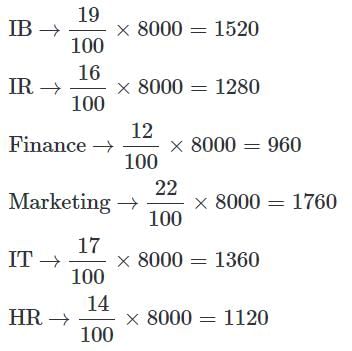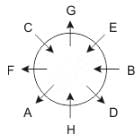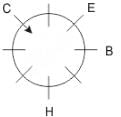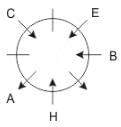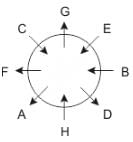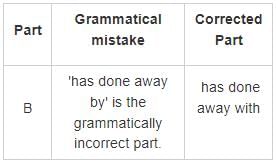SSC CGL (Tier II) Practice Test - 22 - SSC CGL MCQ
30 Questions MCQ Test - SSC CGL (Tier II) Practice Test - 22
Direction: Study the pie-chart given below carefully and answer the questions that follow.
Percentage-wise break up of students in terms of specialization in M.B.A.
Total Number of students = 8000.

Q. What is the total number of students having IB as specialisation?
Percentage-wise break up of students in terms of specialization in M.B.A.
Total Number of students = 8000.

Who is taller among A, B, C, D, and E?
I. D is shorter than B. A is shorter than only E.
II. B is taller than only D. E is taller than A and C.
I. D is shorter than B. A is shorter than only E.
II. B is taller than only D. E is taller than A and C.
Directions: These questions are based on the following information, read the comprehension carefully to answer the given questions.
Eight people A, B, C, D, E, F, G and H are sitting around a circular table but not necessarily in the same order. Some are facing inside and some are facing outside. Not more than two people facing same direction are sitting together.
H sits third to the right of C who is not facing outside. Immediate neighbours of H are facing same directions with respect to each other but opposite direction with respect to H who is facing inside. B is the immediate neighbor of E and both are facing same direction. E sits second to the left of C who is not the immediate neighbor of B. There are equal number of persons facing inside and outside direction. B sits third to the left of A and both are facing opposite directions to each other. H sits to the immediate right of D. F sits second to the left of G.
Q. If all the persons sitting are equidistant and if H faces south direction, what direction will B be facing?
Read the following statements carefully to answer the questions:
I. X is older than L.
II. M and N are of equal age.
III. Z is the youngest.
IV. Y is younger than N.
V. Y is older than X.
Q. Which two of the above statements indicate tham Y is older than L?
Read the following statements carefully to answer the questions:
I. X is older than L.
II. M and N are of equal age.
III. Z is the youngest.
IV. Y is younger than N.
V. Y is older than X.
Q. Which statement(s) indicate(s) than N is older than Z?
Directions: A word and number arrangement machine, when given an input line of words and numbers, rearranges them following a particular rule in each step. The following is an illustration of input and rearrangement.
Input: hard 27 nut 14 impossible 54 to 86 crack 62
Step1:54 hard 27 nut 14 impossible 86 crack 62 to
Step2:86 54 hard 27 14 impossible crack 62 to nut
Step3:14 86 54 hard 27 crack 62 to nut impossible
Step4:62 14 86 54 27 crack to nut impossible hard
Step5:27 62 14 86 54 to nut impossible hard crack
Step 5 is the final output.
Find the different steps of output using the above-mentioned logic for the following input.
Input: deeds 39 for 96 humanity 75 give 27 pleasure 62
Q. In which of the following steps, 96 is seen exactly between 62 and 75 for the first time?
Directions: A word and number arrangement machine, when given an input line of words and numbers, rearranges them following a particular rule in each step. The following is an illustration of input and rearrangement.
Input: hard 27 nut 14 impossible 54 to 86 crack 62
Step1:54 hard 27 nut 14 impossible 86 crack 62 to
Step2:86 54 hard 27 14 impossible crack 62 to nut
Step3:14 86 54 hard 27 crack 62 to nut impossible
Step4:62 14 86 54 27 crack to nut impossible hard
Step5:27 62 14 86 54 to nut impossible hard crack
Step 5 is the final output.
Find the different steps of output using the above-mentioned logic for the following input.
Input: deeds 39 for 96 humanity 75 give 27 pleasure 62
Q. Four of the following five are alike in a certain way and thus form a group. Which of the following does not belong to the group?
Directions to Solve
In each of the following questions find out the alternative which will replace the question mark.
Question -
Carbon : Diamond :: Corundum : ?
Directions to Solve: In each of the questions below consists of a question and two statements numbered I and II given below it. You have to decide whether the data provided in the statements are sufficient to answer the question. Read both the statements and
Give answer:
- (A) If the data in statement I alone are sufficient to answer the question, while the data in statement II alone are not sufficient to answer the question
- (B) If the data in statement II alone are sufficient to answer the question, while the data in statement I alone are not sufficient to answer the question
- (C) If the data either in statement I alone or in statement II alone are sufficient to answer the question
- (D) If the data given in both statements I and II together are not sufficient to answer the question and
- (E) If the data in both statements I and II together are necessary to answer the question.
Question: What is the code for 'or' in the code language?
Statements:
I.'nik sa te' means 'right or wrong', 'ro da nik' means 'he is right' and 'fe te ro' means 'that is wrong'.
II.'pa nik la' means 'that right man', 'sa ne pa' means 'this or that' and 'ne ka re' means 'tell this there'.
Directions: Read the passage given below and answer the questions that follow by choosing the correct/most appropriate options:
The newspaper rule of thumb is that ‘dog-bites-man’ stories are not newsworthy. However, with a nearly 1.5 crores stray dog population (2019 livestock census), and a dubious distinction of being the world’s dog-bite-and-rabies-capital, India’s ‘stray dog menace’ has a steady presence in the media ecosystem, to the point of being anaesthetising. Occasionally, this stupor is broken by the macabre. An infant in a Rajasthan hospital was reportedly taken away by stray dogs, while strays attacked a four-year-old, with fatal results, which were captured by CCTV cameras, in Telangana. Both incidents constitute only a fraction of the many dog attacks. Despite the acknowledgment of the crisis by States, the Centre, the judiciary, municipalities, and non-governmental organizations, the problem festers.
Dogs have a unique relationship with man’s evolutionary history — one of companionship. This poses a moral dilemma of being responsible for their welfare but also confronting the vagaries of their evolution from wolves and their territorial instincts. While by no means a conundrum unique to India, much of the world has drawn the line by de-recognizing the rights of stray animals: if leashed and registered, human custodians are obliged to take care of them. If not, the state — as a last resort — is encumbered to euthanize them, in the interest of public health. The Prevention of Cruelty to Animals (PCA) Act and the Animal Birth Control (Dogs) Rules, 2001 (being updated), while aimed at limiting the stray population, do nothing to improve public safety. The proposed draft rules, or the Animal Birth Control Rules, 2022, only put forth procedural changes in sterilization and vaccination, permit only “incurably ill and mortally wounded” dogs to be euthanized, which is what existing rules permit, and make leaders of resident welfare associations responsible for feeding strays in pockets. The PCA and ABC rules acknowledge that unchecked strays must be restrained. However, they do not factor in the magnitude of the problem: that there is nearly one stray for every 100 Indians; that India lacks the infrastructure and mechanism to ensure that the most vulnerable (the poor and their children) are able to access treatment and that expecting dog numbers to reduce on their own with sterilization and vaccination is a pipe dream. India has committed to eliminating rabies by 2030, but without first framing the threat from stray dogs as a public health crisis, India’s poorest will continue to see their right to safe public spaces culled at the altar of callous activism.
Q. Choose the antonym of the word 'Fatal'.
Directions: Read the passage given below and answer the questions that follow by choosing the correct/most appropriate options:
The newspaper rule of thumb is that ‘dog-bites-man’ stories are not newsworthy. However, with a nearly 1.5 crores stray dog population (2019 livestock census), and a dubious distinction of being the world’s dog-bite-and-rabies-capital, India’s ‘stray dog menace’ has a steady presence in the media ecosystem, to the point of being anaesthetising. Occasionally, this stupor is broken by the macabre. An infant in a Rajasthan hospital was reportedly taken away by stray dogs, while strays attacked a four-year-old, with fatal results, which were captured by CCTV cameras, in Telangana. Both incidents constitute only a fraction of the many dog attacks. Despite the acknowledgment of the crisis by States, the Centre, the judiciary, municipalities, and non-governmental organizations, the problem festers.
Dogs have a unique relationship with man’s evolutionary history — one of companionship. This poses a moral dilemma of being responsible for their welfare but also confronting the vagaries of their evolution from wolves and their territorial instincts. While by no means a conundrum unique to India, much of the world has drawn the line by de-recognizing the rights of stray animals: if leashed and registered, human custodians are obliged to take care of them. If not, the state — as a last resort — is encumbered to euthanize them, in the interest of public health. The Prevention of Cruelty to Animals (PCA) Act and the Animal Birth Control (Dogs) Rules, 2001 (being updated), while aimed at limiting the stray population, do nothing to improve public safety. The proposed draft rules, or the Animal Birth Control Rules, 2022, only put forth procedural changes in sterilization and vaccination, permit only “incurably ill and mortally wounded” dogs to be euthanized, which is what existing rules permit, and make leaders of resident welfare associations responsible for feeding strays in pockets. The PCA and ABC rules acknowledge that unchecked strays must be restrained. However, they do not factor in the magnitude of the problem: that there is nearly one stray for every 100 Indians; that India lacks the infrastructure and mechanism to ensure that the most vulnerable (the poor and their children) are able to access treatment and that expecting dog numbers to reduce on their own with sterilization and vaccination is a pipe dream. India has committed to eliminating rabies by 2030, but without first framing the threat from stray dogs as a public health crisis, India’s poorest will continue to see their right to safe public spaces culled at the altar of callous activism.
Q. Which of the following is/are incorrect according to the given passage?
A. Despite the acknowledgment of the threat from stray dogs by government and non-governmental organizations, the problem festers.
B. The PCA Act and the Animal Birth Control (Dogs) Rules do everything to improve public safety.
C. Dogs don't have a unique relationship with man’s evolutionary history.
Directions: Read the passage given below and answer the questions that follow by choosing the correct/most appropriate options:
The newspaper rule of thumb is that ‘dog-bites-man’ stories are not newsworthy. However, with a nearly 1.5 crores stray dog population (2019 livestock census), and a dubious distinction of being the world’s dog-bite-and-rabies-capital, India’s ‘stray dog menace’ has a steady presence in the media ecosystem, to the point of being anaesthetising. Occasionally, this stupor is broken by the macabre. An infant in a Rajasthan hospital was reportedly taken away by stray dogs, while strays attacked a four-year-old, with fatal results, which were captured by CCTV cameras, in Telangana. Both incidents constitute only a fraction of the many dog attacks. Despite the acknowledgment of the crisis by States, the Centre, the judiciary, municipalities, and non-governmental organizations, the problem festers.
Dogs have a unique relationship with man’s evolutionary history — one of companionship. This poses a moral dilemma of being responsible for their welfare but also confronting the vagaries of their evolution from wolves and their territorial instincts. While by no means a conundrum unique to India, much of the world has drawn the line by de-recognizing the rights of stray animals: if leashed and registered, human custodians are obliged to take care of them. If not, the state — as a last resort — is encumbered to euthanize them, in the interest of public health. The Prevention of Cruelty to Animals (PCA) Act and the Animal Birth Control (Dogs) Rules, 2001 (being updated), while aimed at limiting the stray population, do nothing to improve public safety. The proposed draft rules, or the Animal Birth Control Rules, 2022, only put forth procedural changes in sterilization and vaccination, permit only “incurably ill and mortally wounded” dogs to be euthanized, which is what existing rules permit, and make leaders of resident welfare associations responsible for feeding strays in pockets. The PCA and ABC rules acknowledge that unchecked strays must be restrained. However, they do not factor in the magnitude of the problem: that there is nearly one stray for every 100 Indians; that India lacks the infrastructure and mechanism to ensure that the most vulnerable (the poor and their children) are able to access treatment and that expecting dog numbers to reduce on their own with sterilization and vaccination is a pipe dream. India has committed to eliminating rabies by 2030, but without first framing the threat from stray dogs as a public health crisis, India’s poorest will continue to see their right to safe public spaces culled at the altar of callous activism.
Q. Which of the following is/are correct according to the given passage?
A. The newspaper rule of thumb is that ‘dog-bites-man’ stories are significant.
B. India’s stray dog menace has a steady presence in the media ecosystem.
C. An infant in a Haryana hospital was reportedly taken away by stray dogs.
Read the following sentence and determine whether there is an error in it. The error, if any, will be in one part of the sentence. If the sentence is error-free, then select ‘No Error’ as your answer.
The modern bourgeoisie society (A)/ has done away by (B)/ class antagonisms but has established (C)/ new conditions of oppression in place of the old ones. (D)
Direction: The following sentences- A, B, C, D, E, and F form a paragraph. Sentence E is fixed in the 5th place and its position cannot be changed. The rest of the sentences are not given in their proper order. Read the sentences and answer the following questions.
A. However, just like the dark clouds, one must understand that these problems are only temporary and that better times would soon come.
B. However, such an occurrence is only temporary.
C. A common sight which everyone must have witnessed is that of dark clouds covering the sky and the sun not being visible.
D. After some time, the clouds would disappear or move away and the sunlight would again brighten up the sky.
E. They are characterized by troubles, pain, misery, disaster, calamities, and tragedies.
F. The troubles in our lives are very much like those dark clouds.
Q. Which sentence should be the second sentence in the paragraph?
Given below is a word, followed by three sentences which consist of that word. Identify the sentences(s) which best express(es) the meaning of the word. Choose option 5 ‘None of the above’ if the word is not suitable in any of the sentences.
ANALYSIS
A. He did a wonderful analysis of the subject after the exam.
B. The man felt dejected seeing the analysis of his new car.
C. A perfect analysis of the land is very essential before a counteroffensive.
Direction- Which of the phrases given below the sentence should replace the word or phrase given in bold in the sentence to make it grammatically correct? If the sentence is correct as it is given and no correction is required, mark 'No correction required' as the answer.
Q. I and he have been wrestling with the difficult examination paper the whole night.
Directions: The given sentence has been broken into four parts. The error, if any, will be in one part of the sentence. Select the option which contains the error-less combination. If all are correct, mark Option 5 as your answer.
Q. Emile Durkheim, the first person to be formally(A)/ recognized as a sociologist and the most(B)/ scientific of the pioneers, conducted a study (C)/ that stand as a research model for sociologists today. (D)/ No error(E)
Rearrange the following five sentences (A), (B), (C), (D) and (E) in the proper sequence to form a meaningful paragraph then answer the questions given below them.
A. The government is reportedly contemplating imposing similar licensing requirements on imports of products such as furniture, toys and sports goods.
B. Ostensibly, these measures — in line with the government’s stated policy of “atma nirbharta” or self reliance — are meant to reduce the country’s import dependence
C. Importers will now require a licence from the government to import fully built television sets into the country.
D. The option of raising duties on imports of certain products is, reportedly, also under consideration.
E. Last week, the Union government imposed restrictions on television imports, much of which are sourced from Vietnam and China, by placing them in the restricted category.
Q. Which of these is FOURTH sentence after rearrangement?
Directions: Read the passage given below and answer the questions that follow by choosing the correct/most appropriate options:
An aggravating factor, often overlooked, is the shape that inequality takes in different segments _____ our society. It is economic on one plane; on others, it is regional, caste, and religious. Some are spelt out, others understated, and still others assumed. Sociologists have identified nine categories of people who are determined to be socially and/or politically and/or economically excluded. These particularly include Dalits, Adivasis, women, and religious minorities. Recent studies on religious minorities who constitute around 20% of India’s population have traced discrimination relating to them to perceptions that relate to the very origins of thinking that brought about the partition of August 1947. They argue that violence was not merely accidental but integral to the foundation of the nation and that the need for fraternity coexisted with the imperative need for restoring social cohesion in segments of society.
Much blame for the haste displayed by decision-makers has been written about on the basis of the documentation made available subsequently and, at this distance of time, its validity cannot be dismissed altogether. A primary concern of the Constitution-makers related to cohesion and integration of the units of the new Republic formally described as ‘A Union of States’. In the words of Sardar Vallabhbhai Patel, ‘the inspiration and the stimulus came from above rather than from below and unless the transplanted growth takes a healthy root in the soil, there will be a danger of collapse and chaos.’ This was amplified by V.P. Menon as the integration ‘of the minds of the people’. Over time, uneven development has characterized the States of the Indian Union. Regional and linguistic diversity characterizes them. And so does uneven economic development and progress, resulting in uneven levels of education, employment, social cohesion, and contentment.
Q. What will fit in the blank taken from the passage: ''An aggravating factor, often overlooked, is the shape that inequality takes in different segments _______ our society.''
Directions: Read the passage given below and answer the questions that follow by choosing the correct/most appropriate options:
An aggravating factor, often overlooked, is the shape that inequality takes in different segments _____ our society. It is economic on one plane; on others, it is regional, caste, and religious. Some are spelt out, others understated, and still others assumed. Sociologists have identified nine categories of people who are determined to be socially and/or politically and/or economically excluded. These particularly include Dalits, Adivasis, women, and religious minorities. Recent studies on religious minorities who constitute around 20% of India’s population have traced discrimination relating to them to perceptions that relate to the very origins of thinking that brought about the partition of August 1947. They argue that violence was not merely accidental but integral to the foundation of the nation and that the need for fraternity coexisted with the imperative need for restoring social cohesion in segments of society.
Much blame for the haste displayed by decision-makers has been written about on the basis of the documentation made available subsequently and, at this distance of time, its validity cannot be dismissed altogether. A primary concern of the Constitution-makers related to cohesion and integration of the units of the new Republic formally described as ‘A Union of States’. In the words of Sardar Vallabhbhai Patel, ‘the inspiration and the stimulus came from above rather than from below and unless the transplanted growth takes a healthy root in the soil, there will be a danger of collapse and chaos.’ This was amplified by V.P. Menon as the integration ‘of the minds of the people’. Over time, uneven development has characterized the States of the Indian Union. Regional and linguistic diversity characterizes them. And so does uneven economic development and progress, resulting in uneven levels of education, employment, social cohesion, and contentment.
Q. Which of the following is/are correct according to the given passage?
A. Religious minorities constitute around twenty percent of India’s population.
B. Five categories of people are determined to be economically excluded.
C. Uneven development has not characterized the States of the Indian Union.
Directions: Read the passage given below and answer the questions that follow by choosing the correct/most appropriate options:
An aggravating factor, often overlooked, is the shape that inequality takes in different segments _____ our society. It is economic on one plane; on others, it is regional, caste, and religious. Some are spelt out, others understated, and still others assumed. Sociologists have identified nine categories of people who are determined to be socially and/or politically and/or economically excluded. These particularly include Dalits, Adivasis, women, and religious minorities. Recent studies on religious minorities who constitute around 20% of India’s population have traced discrimination relating to them to perceptions that relate to the very origins of thinking that brought about the partition of August 1947. They argue that violence was not merely accidental but integral to the foundation of the nation and that the need for fraternity coexisted with the imperative need for restoring social cohesion in segments of society.
Much blame for the haste displayed by decision-makers has been written about on the basis of the documentation made available subsequently and, at this distance of time, its validity cannot be dismissed altogether. A primary concern of the Constitution-makers related to cohesion and integration of the units of the new Republic formally described as ‘A Union of States’. In the words of Sardar Vallabhbhai Patel, ‘the inspiration and the stimulus came from above rather than from below and unless the transplanted growth takes a healthy root in the soil, there will be a danger of collapse and chaos.’ This was amplified by V.P. Menon as the integration ‘of the minds of the people’. Over time, uneven development has characterized the States of the Indian Union. Regional and linguistic diversity characterizes them. And so does uneven economic development and progress, resulting in uneven levels of education, employment, social cohesion, and contentment.
Q. Choose the synonym of the word 'Aggravating'.
A passage has been given below. Few words and sentences have been highlighted to help you answer some of the questions. Read the same carefully and answer the questions that follow:
Ideas and actions rarely get wind together to end decades-old social inequities. Visions can become virtuies if they are accompanied by a determination to create an equitable society. Three years ago, Prime Minister Narendra Modi decided to offload the past that was holding back the 1.3 crore citizens of Jammu and Kashmir from realizing their potential. He rolled out the process to build a new and vibrant Union Territory. Jammu and Kashmir, since then, is walking the PM’s talk and has travelled quite a distance to re-arrange priorities of development, initiate deep reforms in governance, curb corruption, and realise the dreams of youth. In this Amrit Kaal, we are the new destination, not just for tourists but for businesses as well.
In 2018-19, only 9,229 projects were completed in a year. This has increased to 50,627 in the financial year 2021-22. Rs 1 lakh crore is being spent to improve road connectivity and build tunnels. Social sector spending has increased by 43.83 per cent and the economic sector by 45.60 per cent in the last three years.
More than 200 public services have been made available online to receive real-time feedback from citizens. Providing houses to people in rural areas, developing roads, putting in place primary health facilities and safe drinking water services, creating more avenues for education, employment, and agriculture, attracting private investment and bridging gaps between government delivery mechanisms and people’s expectations were some of the tasks we completed by building trust between the administration and the people. Structural and institutional changes like ending the 150-year-old Darbar Move brought in another layer of transparency and improvement in governance. It also saved about Rs 400 crore annual expenditure that used to be incurred in shifting logistics from Srinagar to Jammu and back. It has also prevented the loss of at least one working month every year.
Projects worth Rs 58,477 crore under the Prime Minister’s Development Package have picked up pace and direction after impediments and bottlenecks that _________ (a) growth — land acquisition, forest clearances, utility shifting and court cases — were removed. Dreams and aspirations are ________________ (b)of the common man in J&K, which has encouraged us to work harder.
Q. Which of the following tasks has not been completed in order to build trust between the administration and the people?
With whom is 'Junagarh Rock Inscription' associated?
The chief casual factor responsible for the decline of handicrafts industry in India was
Certificate of Deposit or CD is a fixed-income financial instrument governed under the Reserve Bank and India (RBI) issued in a dematerialized form. What is the minimum denomination of Certificate of Deposits?
What was the name of the first modern analog computer and who invented it?A


